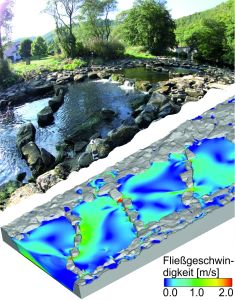During the annual conference of the KIT Climate and Environment Center on July 09, three young scientists of KIT will be granted the Sparkassen-Umwelt-Preis (Sparkasse Environmental Award) for their outstanding graduation theses. Franz Dichgans studied the hydraulics of a riverbed slide that allows fish to pass the river again. Dr. Jan Ungelenk optimized a photocatalyst for use in water treatment and the medical sector. Dr. Frederik Trippe developed a technico-economic model to assess biomass-to-liquid concepts. Representatives of the media and the interested public are cordially invited to attend the awards ceremony at the Tulla Lecture Hall on KIT Campus South.
With the 2013 Sparkasse Environmental Award in the total amount of EUR 15,000, the Karlsruhe Institute of Technology (KIT) and the Environmental Foundation of the Sparkasse Karlsruhe Ettlingen acknowledge outstanding doctoral, diploma, and master theses or academic project work relating to environmental research. The departments of KIT are requested to propose candidates. For the year 2013, the award is granted to one diploma thesis and two doctoral theses.
The diploma thesis “Numerical Modeling of a Close-to-nature Riverbed Slide” by Franz Dichgans contributes to enhancing the ecological compatibility of hydraulic engineering structures. To allow fish to pass rivers again, numerous fish ladders were built in the past years at river weirs and other lateral structures in the water. The so-called riverbed slides compensate height differences. Hydraulic dimensioning of such structures is very difficult due to the formation of complex flow patterns. Dichgans studied the hydraulics of an existing riverbed slide in detail by combining terrestrial laser scanning with high-resolution hydrodynamico-numerical models. His study provided comprehensive information on the flow characteristics of the construction. This allows conclusions to be drawn with respect to the (fish-) ecological and hydraulic dimensioning of future riverbed slides.
“Tin Tungstate – A Solar Activable Photocatalyst” is the subject of the doctoral thesis written by Dr. Jan Ungelenk. Photocatalysis allows for the direct conversion of light energy into chemical energy. It is used to decompose environmental pollutants and to reprocess water by photodisinfection. Tin tungstate cannot only be activated by UV, but also by longer-wave light. Hence, the natural solar spectrum can be used efficiently as a light source. This opens up new applications in medicine, such as minimally invasive therapy of tumors by irradiation with cell-compatible visible light. Dr. Jan Ungelenk characterized the so far hardly accessible cubic tin tungstate, optimized it for photocatalysis, and tested its application potentials.
A “Technico-economic Assessment of Process Configurations Other than the Production of Biomass-to-liquid (BtL) Fuels and Chemicals” is in the focus of Dr. Frederik Trippe’s doctoral thesis. Biomass can be used for the direct production of electricity and heat as well as for the production of fuels and chemicals. Using the KIT-developed bioliq® process as an example, which is a BtL concept using residues from agriculture and forestry, Dr. Frederik Trippe developed a technico-economic assessment model that combines technical design parameters directly with their economic impacts. The model yields results for energy and mass balances, estimated investments, and costs of the conversion and production of intermediate and end products.
At its annual conference, the KIT Climate and Environment Center will present latest research results. The keynote speech will be made by Professor Frank Schilling, Head of the Petrophysics Division of the Institute of Applied Geosciences (AGW) of KIT. His subject will be “Georesources – Protecting the Environment or Exporting Risks.” Among others, Schilling will speak about CO2 separation and storage, shale gas, geothermal energy, and mineral resources. A poster exhibition at the conference will cover doctoral theses that are presently being written at the GRACE Graduate School. At GRACE, the KIT Climate and Environment Center, together with the University of Darmstadt and the ESADE Business School, Barcelona, conveys specific and interdisciplinary knowledge as well as key qualifications to doctoral students.
Program: Annual Conference of the KIT Climate and Environment Center
Wednesday, July 09, 2014, 16.30 hrs, Tulla Lecture Hall (building 11.40), KIT Campus South
Welcome Addresses
Professor Detlef Löhe, KIT Vice President for Research and Information
Dr. Frank Mentrup, Lord Mayor of the City of Karlsruhe
Michael Huber, Chief Executive Officer of the Sparkasse Karlsruhe Ettlingen
2013 Sparkasse Environmental Awards Ceremony and Short Presentations by the Winners
Franz Dichgans
Numerical Modeling of a Close-to-nature Riverbed Slide
Dr. Jan Ungelenk
Tin Tungstate – A Solar Activable Photocatalyst
Dr. Frederik Trippe
Technico-economic Assessment of Process Configurations Other than the Production of Biomass-to-liquid (BtL) Fuels and Chemicals
News of the KIT Climate and Environment Center
Professor Johannes Orphal
Scientific Spokesman of KIT’s Climate and Environment Center
Keynote Speech: Georesources – Protecting the Environment or Exporting Risks
Professor Frank Schilling, Institute of Applied Geosciences
Reception with snacks and music and
Poster session about GRACE doctoral theses
The KIT Climate and Environment Center develops strategies and technologies to secure the natural bases of life. For this purpose, 660 employees of 32 institutes produce fundamental and application-oriented knowledge relating to climate and environmental change. It is not only aimed at eliminating the causes of environmental problems, but increasingly at adapting to changed conditions.
Being “The Research University in the Helmholtz Association”, KIT creates and imparts knowledge for the society and the environment. It is the objective to make significant contributions to the global challenges in the fields of energy, mobility, and information. For this, about 10,000 employees cooperate in a broad range of disciplines in natural sciences, engineering sciences, economics, and the humanities and social sciences. KIT prepares its 22,800 students for responsible tasks in society, industry, and science by offering research-based study programs. Innovation efforts at KIT build a bridge between important scientific findings and their application for the benefit of society, economic prosperity, and the preservation of our natural basis of life. KIT is one of the German universities of excellence.

